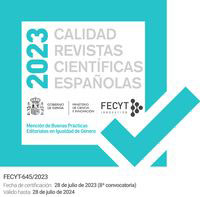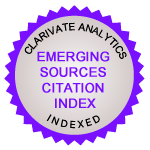Los festivales de música como inductores de imagen de destino turístico. El caso del Festival Vodafone Paredes de Coura
DOI:
https://doi.org/10.14198/INTURI2019.17.07Palabras clave:
imagen de destino, evento, festival de música, imagen cognitivaResumen
Turismo y eventos no son un fenómeno reciente, lo que es novedoso es la importancia y la influencia de los eventos en la imagen del destino. Los eventos estimulan el desarrollo de los destinos, son instrumentos de construcción de imagen de un territorio, aumentan la visibilidad turística y complementan la promoción turística. En la oferta de eventos de tipo turístico, destacan los festivales de música y entre ellos el Festival Vodafone de Paredes de Coura (con más de 100.000 asistentes), que se celebra en la villa de Paredes de Coura en el destino turístico Porto y Norte (Portugal). La presente comunicación tiene como objetivo principal verificar si la imagen del festival afecta positivamente a la imagen del destino turístico. Para ello, se ha diseñado una encuesta y se ha recogido de modo aleatorio a 395 asistentes al festival, en la que se valoran un total de 24 ítems sobre la imagen del festival y del destino y se analiza el perfil del festivalero.
Citas
Agapito, D., Valle, P. O., y Mendes, J. D. (2013). The Cognitive-Affective-Conative Model of Destination Image: A Confirmatory Analysis. Journal of Travel & Tourism Marketing, 30 (5), 471-481. http://dx.doi.org/10.1080/10548408.2013.803393
Añaña, E. D., Anjos F., y Pereira, M. D. (2016). Imagem de Destinos Turísticos: avaliação à luz da teoria da experiência na economia baseada em serviços. Revista Brasileira de Pesquisa em Turismo, 10 (2), 309-329. http://dx.doi.org/10.7784/rbtur.v10i2.1093
Araújo Vila, N., y Domínguez Vila, T. (2012). Los festivales de cine como elemento potenciador de destinos turísticos. El caso de San Sebastián”. Revista de Comunicación Vivat Academina, 121, 31-49.
APORFEST (Associação Portuguesa Festivais de Música) (2017). 249 festivais de música em Portugal no ano de 2016. Online in http://www.aporfest.pt/single-post/2016/09/22/243-festivais-de-m%C3%BAsica-em-Portugal-no-ano-de-2016-estudo-Aporfest
Baloglu, S., y McCleary, K. W. (1999). A Model of Destination Image Formation. Annals of Tourism Research, 26 (4), 868-897 https://doi.org/10.1016/S0160-7383(99)00030-4
Beerli, A., y Martín, J. D. (2004). Tourists' characteristics and the perceived image of tourist destinations: a quantitative analysis-a case study of Lanzarote, Spain. Tourism Management, 25, 623-636 http://doi.org/10.1016/j.tourman.2003.06.004
Brea, J. F., y Cardoso, L. (2011). Tourism Destination Image: reflexão sobre as principais investigações internacionais. Cultur: Revista de Cultura e Turismo, 5(2), 4-18.
Buglear, J. (2012). Quantitative Methods for Business and Management. Harlow: Pearson.
Cardoso, L., y Brea, J. F. (2012). Medição da Tourism Destination Image: implicações para os markters do destino turístico. XVII Congresso AECIT (Associação Espanhola de Especialistas Científicos em Turismo), 1-16.
Chierichetti, L. (2012). La promoción del turismo musical: Los festivales de música en Facebook. Pasos, Revista de Turismo y Patrimonio Cultural, 10 (4), 49-58.
Custódio, M. J. F., y Gouveia, P. M. (2007). Evaluation of the cognitive image of a country/destination by the media during the coverage of mega‐events: the case of UEFA EURO 2004TM in Portugal. International Journal of Tourism Research, 9(4), 285-296.
Echtner, C. M., y Ritchie, J. R. (2003). The Meaning and Measurement of Destination Image. Journal of Tourism Studies, 14(1), 37-48 https://doi.org/0.1177/004728759303100402
Estrada, M., Sotos, J., y Monteferrer, D. (2015). Los festivals musicales como experiencia turística: una aproximación teórica. International Journal of Marketing, Communication and New Media, 3(4), 43-53
Gallarza, M. G., Saura, I. G., y García, H. C. (2002). Destination Image Towards a Conceptual Framework. Annals of Tourism Research, 29(1), 56-78 https://doi.org/https://doi.org/10.1016/S0160-7383(01)00031-7
Gartner, W. C. (1993). Image Formation Process. Journal of Travel & Tourism Marketing, 2(2-3), 191-215 https://doi.org/10.1300/J073v02n02
Getz, D. (2008). Event tourism: definition, evolution, and research. Tourism Management, 29, 403-428. 10.1016/j.tourman.2007.07.017
Getz, D., y Page, S. J. (2016). Progress and prospects for event tourism research. Tourism Management, 52, 593-631.
Grappi, S., y Montanari, F. (2011). The role of social identification and hedonism in affecting tourist re-patronizing behaviours: the case of an Italian festival. Tourism Management, 32, 1128-1140. 0.1016/j.tourman.2010.10.001
Hallmann, K., Zehrer, A., y Müller, S. (2015). Perceived Destination Image: An Image Model for a Winter Sports Destination and Its Effect on Intention to Revisit. Journal of Travel Research, 54(1), 94-106 https://doi.org/10.1177/0047287513513161
Hosany, S., Ekinci, Y., y Uysal, M. (2007). Destination Image and Destionation Personality. International Journal of Culture, Tourism and Hospitality Research, 1(1), 62-81 https://doi.org/10.1108/17506180710729619
Hosany, S., y Witman, M. (2010). Dimensions of cruisers' experiences, satisfaction, and intention to recommend. Journal of Travel Research, 49, 351-364. https://doi.org/10.1177/0047287509346859
Hunter, W. C. (2016). The social construction of tourism online destination image: A comparative semiotic analysis of the visual representation of Seoul. Tourism Management, 54, 221-229 https://doi.org/10.1016/j.tourman.2015.11.012
Josiassen, A., Assaf, A. G., Woo, L., y Kock, F. (2016). The Imagery–Image Duality Model: An Integrative Review and Advocating for Improved Delimitation of Concepts. Journal of Travel Research, 55(6), 789-803.
Lee, J. S., Lee, C. K., y Choi, Y. (2011) Examining the role of emotional and functional values in festival evaluation. Journal of Travel Research, 50(6), 685-696. https://doi.org/10.1177/0047287510385465
Leenders, M. A. (2010). The relative importance of the brand of music festivals: a customer equity perspective. Journal of Strategic Marketing, 18(4), 291-301
Liu, Y. (2014). Cultural events and cultural tourism development: lessons from the European Capitals of Culture. European Planning Studies, 22 (3), 498-514. http://dx.doi.org/10.1080/09654313.2012.752442
Llodrá-Riera, I., Martinez-Ruiz, M. P., Jiménez-Zarco, A. I., y Izquierdo-Yusta, A. (2015). A multidimensional analysis of the information sources construct and its relevance for destination image formation. Tourism Management, 48, 319-328 https://doi.org/10.1016/j.tourman.2014.11.012
Llopis Amorós, M. P., Gil Saura, I., y Ruiz Molina, M. E. (2017). Comunicaciones de marketing y valor de marca de un festival musical.
Loureiro, S. C., y Araujo, A. B. (2015). Negative Film Plot and Tourists´ Image and Intentions: The Case of City of God. Journal of Travel & Tourism Marketing, 32(4), 352-365 https://doi.org/10.1080/10548408.2014.896769
Mak, A. H. (2017). Online destination image: Comparing national tourism organisation's and tourists' perspectives. Tourism Management, 60, 280-297 https://doi.org/10.1016/j.tourman.2016.12.012 0261-5177
Martín-Santana, J. D., Beerli-Palacio, A., y Nazzareno, P. A. (2017). Antecedents and consequences of destination image gap. Annals of Tourism Research, 62, 13-25 https://doi.org/10.1016/j.annals.2016.11.001
Morales, M. J., y Vela, J. D. (2009). Identidad territorial y promoción turística : la organización de eventos como estrategia de creación , consolidación y difusión de la imagen de marca del territorio. Zer - Revista de Estudios de Comunicación, 14(26), 277-297.
Önder, I., y Marchiori, E. (2017). A comparison of pre-visit beliefs and projected visual images of destinations. Tourism Management Perspectives, 21, 42-53.
Paiva, R. (2015). Eventos e megaeventos: ócio e negócio no turismo. Revista Brasileira de Pesquisa em Turismo, 9(3), 479-499.
Pan, B., y Li, X. (2011). The long tail of destination image and online marketing. Annals of Tourism Research, 38(1), 132-152 https://doi.org/10.1016/j.annals.2010.06.004
Pavluković, V., Armenski, T., y Alcántara-Pilar, J. (2017). Social impacts of music festivals: Does culture impact locals' attitude toward events in Serbia and Hungary? Tourism Management, 63, 42-53.
Pike, S. (2016). Destination image: Identifying baseline perceptions of Brazil, Argentina and Chile in the nascent Australian long haul travel market. Journal of Destination Marketing & Management, 5, 164-170 https://doi.org/10.1016/j.jdmm.2015.12.006
Prat, J. M. (2014). Las relaciones sociales y las motivaciones para asistir al festival de música de peralada. Boletín de la Asociación de Geógrafos Españoles, 66, 207-221.
Santos, J. D., Vareiro, L., Remoaldo, P., y Ribeiro, J. C. (2017). Cultural mega-events and the enhancement of a city's image : differences between engaged participants and attendees. Journal of Policy Research in Tourism, Leisure & Events, 9(2), 129–151 http://doi.org/10.1080/19407963.2016.1157598
Seonjeong, A. M. Liang, L. R., y Chiang, T. L. (2014). The experience economy approach to festival marketing: Vivid memory and attendee loyalty. Journal of Services Marketing, 28 (1), 22-35. https://doi.org/10.1108/JSM-06-2012-0105
Stepchenkova, S., y Li, X. (2014). Destination image: Do top-of-mind associations say it all? Annals of Tourism Research, 45, 46-62 https://doi.org/10.1016/j.annals.2013.12.004
Stepchenkova, S., y Morrison, A. M. (2008). Russia's destination image among American pleasure travelers: Revisiting Echtner and Ritchie. Tourism Management, 29(3), 548-560 https://doi.org/10.1016/j.tourman.2007.06.003
Stylos, N., Bellou, V., Andronikidis, A., y Vassiliadis, C. A. (2017). Linking the dots among destination images, place attachment, and revisit intentions: A study among British and Russian tourists. Tourism Management, 60, 15-29 https://doi.org/10.1016/j.tourman.2016.11.006
Tanford, S., y Jung, S. (2017). Festival attributes and perceptions: A meta-analysis of relationships with satisfaction and loyalty. Tourism Management, 61, 209-220.
Weaver, D. B., y Lawton, L. J. (2013). Resident perceptions of a contentious tourism event. Tourism Management, 37, 165-175.
Yan, G., Kloeppel, M., y Li, X. (2017). Producing Extreme Metal festivals: An analysis from Lacan's gaze. Tourism Management, 59, 579-589 https://doi.org/10.1016/j.tourman.2016.09.014
Zucco, F. D., de Quadros, C. M., Schmitt, J., y Fiuza, T. F. (2017). Imagem e identidade turísticas relacionadas às práticas e bens culturais percebidas pelos residentes: perspectivas a partir da cidade de Blumenau, Santa Catarina, Brasil. Revista Brasileira de Pesquisa em Turismo, 11(2), 320-346.
Descargas
Estadísticas
Publicado
Cómo citar
Número
Sección
Licencia
Derechos de autor 2019 Lucília Cardoso, Noelia Araújo Vila, Ângela de Almeida, Jose Antonio Fraiz Brea

Esta obra está bajo una licencia internacional Creative Commons Atribución 4.0.





